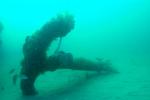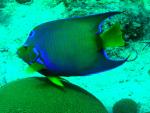| [singlepic=111,400,300,,left] |
| The bow of the Chaparra |
Chapara November 1, 2008
Summary:
57 degrees top to bottom
50+ ft of visibility
Lobster, tog, sea bass, and dog fish.
NOAA was calling for a front to go through and swing the winds around from southeast to northwest. If all went according to plan, it should be an nice day on the water. When we pulled out of the inlet the conditions seemed better than the forecast, but as we got further out, the south east swell started showing. With our destination, and the wind coming from another direction, we were taking them on the beam, even at anchor. The swell was not big, but caused a lot of roll.
| [singlepic=110,400,300,,left] |
| Solitary boiler out in the sand |
Once Chris had us tied in, everyone started rolling in. Before long Chris was up with a report on the conditions. Dark, but clear on the bottom, and dog fish circling the line. Roger and I jumped in as the passengers started to surface.
Given the logistics, I opted for one long dive rather than two short ones. With camera in tow, I dropped down into the water. The dogfish were there just as bouncy castle for sale Chris had noted, however, they were not hanging around for pictures. The descent was murky, but opened up about 30 ft off the bottom. Chris had us tied into the prop shaft, but the prop is long gone.
| [singlepic=119,400,300,,left] |
| The other two boiler surrounded by fish |
Schools of juvenile sea bass circled the area between the three large boilers. Larger fish could be seen darting in and out of the boilers, and out from under the deck plates. The wreck lays on the starboard side with the bow section about 50 ft off in the sand. The skin of the ship is disappearing with time, leaving only the ribs jutting out of the sand. Here lobster, sea bass, and tog take refuge.
Once the rest of the divers were gone, the fish started to come out of hiding. There were a few large tog and a couple of trigger fish hiding in the boilers.
| [singlepic=109,400,300,,] |
| The port anchor still in the hawse pipe |
The bow section was covered with fish. Again schools of juveniles, as well as some larger sea bass and tog hiding in between the ribs. The last bulkhead of the bow section looks to have housed the deck winch for lifting the large anchor. On the other side, draped in line, the large port anchor can be seen still in the hawse pipe. Down at the bow dogfish cruised by regularly, checking for a quick meal. Now they didn’t seem to mind posing for the camera.
| [singlepic=118,400,300,,] |
| The skin falling away |
With the warm bottom temp, and lots to see, the time went quickly. Looking at my bottom timer, it had already been 2 hours, and it was time to head up. The other divers were beginning to show up again, and the fish went back into hiding.
Back on the surface, the rollers had died down nicely. It seemed like a completely different day. Chris jumped in with directions to the trigger fish, and plans to pull the hook. We were soon underway. Another Great day of diving.
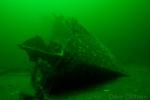 Chaparra, Nov 08
Chaparra, Nov 08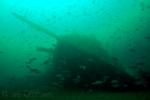 Mohawk, Oct 08
Mohawk, Oct 08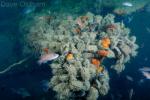 Gulf Trade Nov, 08
Gulf Trade Nov, 08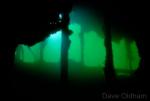 Pinta Nov, 08
Pinta Nov, 08